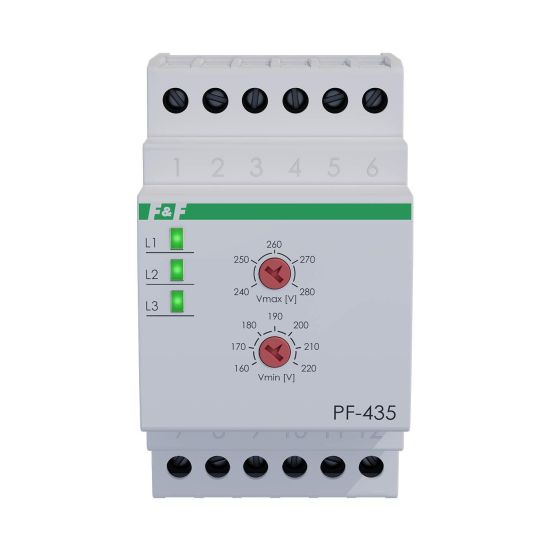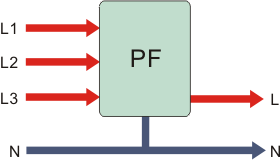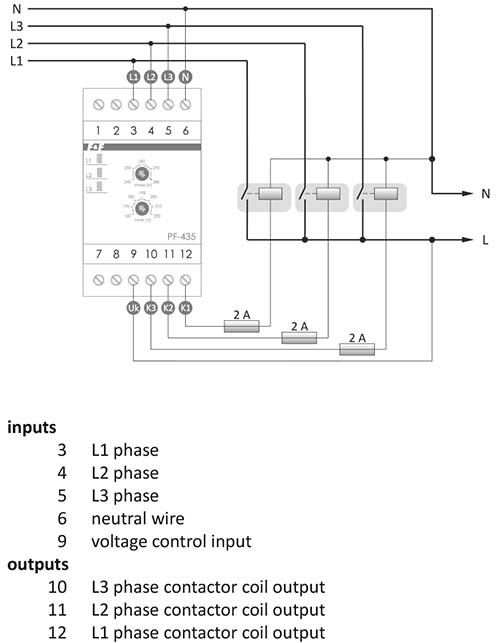






The PF-435 TRMS automatic phase switch is used to maintain the continuity of the power supply of a single-phase receiver in case of phase failure or when the phase exceeds preset parameters. The compact size of the device allows you to save space in the electrical cabinet.
By measuring the RMS value of the voltage (True RMS), the switch guarantees the correct operation even when operating with a severely disturbed power supply network.

Działanie
Three-phase voltage (3×230 V+N) is connected to the input terminals of the device. At the output of the relay, the single-phase voltage (230 V) of one of the phases appears. The electronic circuit of the switch controls the voltage values of the supplied phases so that the output voltage is not lower or higher than the set values. The phase with the correct parameters is directed to the output switch. The device measures the RMS value (True RMS) of the voltage, so it is perfect for modern automation systems, where the supply voltage is often distorted due to the operation of nearby devices with pulse power supplies. The corresponding green LED light indicates that the phase is connected to the output of the switch. All phases have the same priority, which means that the first of the correct phases will be connected to the output (when the power is switched on, the check starts from phase L1). The output phase will only be changed when the output voltage exceeds the range 207÷253 V. If the output phase voltage is 10 V below 207 V, or 10 V above 253 V, the switchover will occur with a 10-second delay. If the phase goes outside this range, it is disconnected immediately (approximately 200 ms).
In both cases, when the voltage of either phase is not in the correct range, the output load is disconnected. Switching the output to a phase with incorrect parameters is not possible. The operating voltage range for all three phases is set using the Vmax and Vmin knobs. The Vmax knob determines the maximum permissible output voltage and the Vmin knob determines the minimum permissible output voltage. If the phase voltage is between the Vmin and Vmax thresholds, it is considered correct.
In addition, the device has a control contact for continuous monitoring of the output status. In this way, it is possible to detect anomalies such as a stuck contact of one of the contactors or a non-functioning contact. If, after all contactors have been switched off, a voltage of more than 20 V is still present at the output for more than 1 s, all LEDs will start flashing. The corresponding contactor will only be switched on when the voltage drops below 20 V. If the decay occurs up to 1 s, the LEDs will not start flashing. This protection detects a possible sticking contact of the contactor, or prevents the contactor from switching on if the output voltage is generated externally. If the contactor of the selected phase is switched on and the output voltage after 1 s is at least 10 V lower than the input voltage, the contact is considered to be faulty. The phase is deactivated until there is a complete voltage loss on the device (reset). This situation is indicated by the flashing of the faulty phase LED.
If the device detects that all 3 contactors are faulty, it will attempt self-repair and after 60 s, all of the outputs will be recognised as operational. If the situation persists and none of the
contacts are operational, all outputs will be blocked until the power supply fails.
